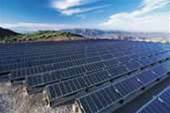
"Because worldwide energy prices are rising fast and PV prices are falling fast, PV will carve off a big slice of the energy market and could eventually account for as much as 20 percent of the US market’s energy needs," said Robert Nolan, analyst at NanoMarkets.
"Because TFPV costs less than conventional PV, TFPV is most likely to take off first. PV also offers predictable pricing, something that fossil fuels cannot do."
The analysts say the total market for TFPV will be worth US$7.2bn by 2015, up from $1bn today. TFPV is easier to build than standard PV cells, since it can be printed out of adapted printers rather than built like computer chips.
Manufacturers are already building large power plants to use the technology, with First Solar, Fuji Electric, Nanosolar, Sanyo, Uni-Solar and G24i all building plants with more than 100MW in capacity.
TFPV is very promising because it can be printed in flexible strips, making it possible to attach to most devices and structures. It is also more effective in lower light conditions than PV cells.

_(22).jpg&h=140&w=231&c=1&s=0)
.png&h=140&w=231&c=1&s=0)

_(20).jpg&h=140&w=231&c=1&s=0)



_(26).jpg&w=100&c=1&s=0)

 iTnews Executive Retreat - Security Leaders Edition
iTnews Executive Retreat - Security Leaders Edition












_(1).jpg&h=140&w=231&c=1&s=0)



